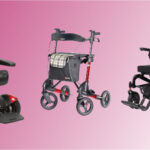
Once upon a time, a silly ramp changed my life. Not just a ramp, mind you, but a bridge to places I couldn't reach before. That's what a helpful disability aid can do.
Now, choosing the right one can feel like climbing a mountain blindfolded. Wheelchairs, canes, scooters – it's enough to make your head spin! But don't worry friend, this guide will provide you with enough information.
Forget boring tech talk. We'll navigate this together, filled with real stories and expert tips. So, whether you're a seasoned adventurer or a curious newcomer, let's find the perfect ally to make your life brighter.
Table of Contents
Assessing your specific needs and limitations
Remember that silly ramp that changed my life? It wasn't magic, it was finding the right disability aid for my new needs. Whether you need occasional support or full-time assistance, a whole world of options awaits to unlock your potential!
This guide will be your compass. We'll break down different types of aids, like trusty canes or sturdy rollators, exploring their features and "need-to-knows" to find your perfect fit. Worries about cost, insurance, or finding the right supplier? We've got you covered! This isn't just about specs, it's about finding the perfect companion to navigate life on your terms. So, let's dive deeper!
What are the different types of disability aids?
Lost in the jungle of disability aids? Don't worry, we'll be your guide! Before you get entangled in options, let's explore the different types of disability aids and find the perfect match for your journey. Here are some of the most common types of disability aids:
1. Wheelchairs: Wheelchairs are a popular choice for individuals with limited mobility. They come in various types, including manual wheelchairs, electric wheelchairs, and lightweight wheelchairs. Each type has its own set of features and benefits.
2. Walking Aids: Walking aids, such as canes, crutches, and walkers, are designed to provide support and stability while walking. Choosing the right walking aid depends on factors such as balance, strength, and the level of support required.
3. Mobility Scooters: Mobility scooters are electric-powered devices that provide a convenient and comfortable way to travel for individuals with mobility challenges. They come in different sizes and configurations, including three-wheel and four-wheel scooters.
Each type of disability aid has its advantages and considerations. Understanding the specific features and benefits of each type will help you make an informed decision.
Unlocking Your Perfect Partner: What Makes the Ideal Disability Aid?
Finding the right disability aid isn't a one-size-fits-all game. It's all about discovering the perfect partner to unlock your independent adventures! But with so many options, where do you start? That's where understanding your unique needs comes in. Let's explore factors like:
- Your Daily Rhythm: Evaluate how you move around and consider any potential changes in the future. This will help you determine the level of support and functionality you need from a disability aid.
- What your body needs support with: Consider any challenges you face around mobility, such as muscle weakness, joint pain, or difficulty with balance. Understanding these challenges will help you choose an aid that provides the necessary support and stability.
- Lifestyle and Activities: Consider your lifestyle and the activities you engage in regularly. Whether you need an aid for indoor use, outdoor use, or both, it's important to choose one that fits seamlessly into your daily routine.
Remember Sarah, an avid gardener, discovered the magic of lightweight, foldable wheelchairs after struggling with uneven terrain. Now, her flowerbeds bloom brighter than ever!
So assessing your specific needs and limitations will ensure that the disability aid you choose is prepared for your unique requirements.
Researching and comparing different brands and models
Choosing the right disability aid involves considering various factors to ensure it meets your specific needs and preferences. Here are some key factors to keep in mind:
- Portability vs. Durability: If you need an aid for travel or limited storage, prioritize portability! Foldable wheelchairs and scooters are lifesavers for globetrotting explorers like Philip, who conquered hidden alleyways with his perfect lightweight find. But don't forget durability! Your ideal aid should be your long-lasting adventure buddy, ready for any journey.
- Ease of Use vs. Comfort: Choose your adventure with an aid that's easy to use and comfy! Adjustable heights, intuitive controls, and snug seating like Sarah's wheelchair, ensure a user-friendly experience and prevent pressure sores. Remember, comfort is key for extended use!
- Safety First: Anti-tip mechanisms, sturdy brakes, and reflective surfaces aren't just extras, they're your protectors. Pick an aid that gives you peace of mind and lets you conquer your days with confidence!
Researching and comparing is your secret weapon for finding the perfect mobility partner. With this guide, you'll unlock a world of freedom and conquer your every adventure!

Get professional advice and recommendations
Once you have identified the type of disability aid that best suits your needs, it's time to research and compare different brands and models.
you can learn from the mistakes of others and avoid making them yourself. Seeking advice opens doors to new possibilities. With this guide, you'll find the perfect aid to boost your mobility and paint your own adventure!
Here are some steps to guide you through the process:
- Online Research: use online resources to gather information about different brands and models. Visit manufacturer websites, read product descriptions, and explore user reviews and ratings.
- Consulting with your health team: Get advice from healthcare professionals, such as physical therapists or occupational therapists. They can provide valuable insights and recommend specific aids based on your individual needs.
- Seeking Recommendations: Reach out to support groups, online forums, or individuals who have firsthand experience with disability aids. Their recommendations can provide valuable insights into the performance and reliability of different brands and models.
- Comparing the cool things it does: Create a list of what makes it tick that is important to you. Compare different brands and models based on these criteria to narrow down your options.
Trying out and testing the disability aids
Test drive time! Before buying, get behind the wheel (or handlebars) of your perfect match! when choosing a disability aid, it's essential to look for professional advice and recommendations.
Consulting with suppliers and manufacturers who specialize in disability aids can provide further assistance. They can offer detailed product information, answer specific questions, and provide recommendations based on your requirements.
Here are some steps to follow when trying out disability aids:
- Visit Showrooms or Exhibitions: Remember that wheelchair I bought after struggling at the mall? I found it at a disability fair! Showrooms are amazing for trying out all the options and picking your perfect partner.
- Test drives before taking the plunge: Some shops let you try out aids before you buy! Take them for a spin in your own space to see if they're a good fit.
- Consider rental options: Before buying, rent an aid for a quick peek! It helps you see if it works well and fits your needs, so you can choose the best ride for the long haul
Considering the cost and ways to lighten the load
Finding the perfect aid isn't just about features, it's about finding the best fit for your budget and lifestyle. We'll help you unlock a world of options without breaking the bank!
Sarah never thought she could afford a lightweight wheelchair, but after exploring grants, she now conquers mountain trails! Let's find your financial superpowers!
Here are some factors to keep in mind:
- Price Range: Research the price range of different disability aids to understand the market value. Consider your budget and prioritize aids that fall within your financial means.
- Insurance Coverage: Check if your health insurance policy covers disability aids. Contact your insurance provider to understand the secret codes of your insurance policy and any specific requirements for reimbursement.
- Financial Assistance Programs: Explore funding fairies that make your dreams take flight are available in your region. Government agencies, non-profit organizations, and charitable foundations may offer grants or subsidies to assist with the purchase of disability aids.
By considering the cost and exploring available financial assistance options, you can make an informed decision that aligns with your budget.
Evaluating the durability and maintenance requirements
Before purchasing a disability aid, it's important to evaluate its durability and maintenance requirements. Consider the following:
- Quality and durability: Research what others say about the company and the overall quality of the disability aid. Look for warranties or guarantees that ensure the product's durability and performance over time. As an example - John loved his fancy scooter, but the battery died on his big trip. Let's avoid that with smart maintenance choices!
- Maintenance needs: Assess the maintenance requirements of the aid, such as battery replacement, regular servicing, or cleaning. Consider whether you have the resources and capacity to fulfill these requirements.
- Finding replacement parts when needed: Check the availability of spare parts for the disability aid. Ensure that the necessary parts can be easily sourced and replaced when needed. As an example - Sarah's wheelchair tire popped mid-hike, but luckily, spare parts were just a click away! Be prepared for anything.
By evaluating the durability and maintenance requirements, you can choose a disability aid that offers longevity and ease of upkeep.

Making the final decision and purchasing the right disability aid
Search for terms like product 'comfort,' 'performance,' or 'portability' to find relevant testimonials. from other users. Look for reviews on reputable websites, forums, or social media groups dedicated to disability aids.
Pay attention to common themes or issues raised by users, as well as positive feedback on specific features or benefits. Leave your questions in the comments and make informed choices based on shared experiences.
Remember, you're not just buying an aid, you're unlocking a world of possibilities! With this guide by your side, choose wisely, conquer your adventures, and live life to the fullest!

